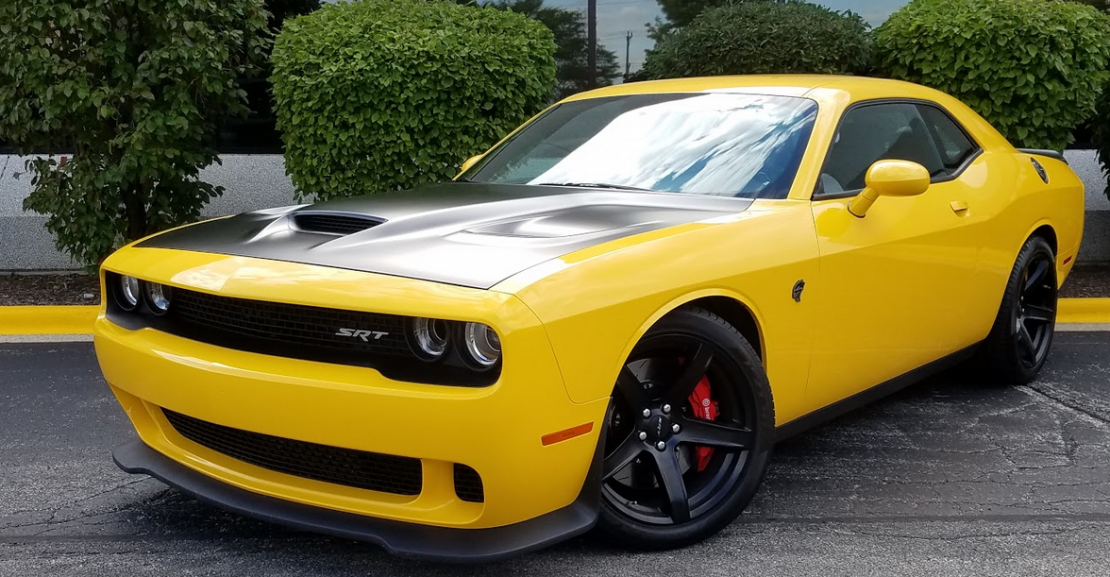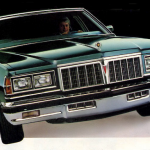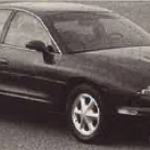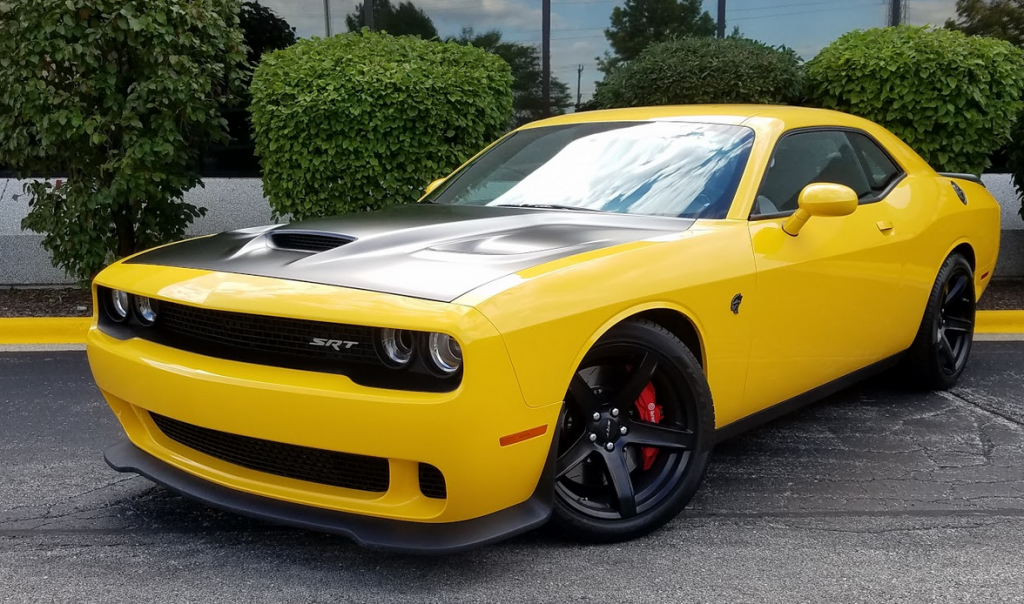
 2017 Dodge Challenger SRT Hellcat
2017 Dodge Challenger SRT Hellcat
Class: Sporty/Performance Car
Miles driven: 208
Fuel used: 17.6 gallons
Real-world fuel economy: 11.8 mpg
Driving mix: 75% city, 25% highway
| CG Report Card | |
|---|---|
| Room and Comfort | B- |
| Power and Performance | A+ |
| Fit and Finish | B |
| Fuel Economy | D- |
| Value | C |
| Report-card grades are derived from a consensus of test-driver evaluations. All grades are versus other vehicles in the same class. Value grade is for specific trim level evaluated, and may not reflect Consumer Guide's impressions of the entire model lineup. | |
| Big & Tall Comfort | |
| Big Guy | B |
| Tall Guy | B |
| Big & Tall comfort ratings are for front seats only. "Big" rating based on male tester weighing approximately 350 pounds, "Tall" rating based on 6'6"-tall male tester. | |
EPA-estimated fuel economy: 13/22/16 (city, highway, combined)
Base price: $62,495 (not including $1095 destination charge)
Options on test vehicle: Hellcat Package 26R ($2995; includes 8-speed automatic transmission, steering-wheel paddle shifters, remote start system, and 2.62 rear-axle ratio), satin black painted hood ($1995), P Zero summer tires ($695), Gas Guzzler Tax ($1700)
Price as tested: $70,975
Quick Hits
The great: Ludicrous horsepower, mind-bending acceleration
The good: Nostalgic muscle-car styling, good passenger and trunk space for the class
The not so good: Awful fuel economy, aging basic design
More Challenger price and availability information
John Biel
Most of what significant change there is for the Dodge Challenger in 2017—the addition of some new models—takes place downstream from the big-boss SRT Hellcat. Not that the ’Cat needs to change all that much to stay in the game. Its astounding 707-horsepower rating is still well clear of the most powerful versions of its two domestic retro “ponycar” rivals, with the added plus of rear-seat passenger room and trunk space that neither the Chevrolet Camaro or Ford Mustang can touch either.
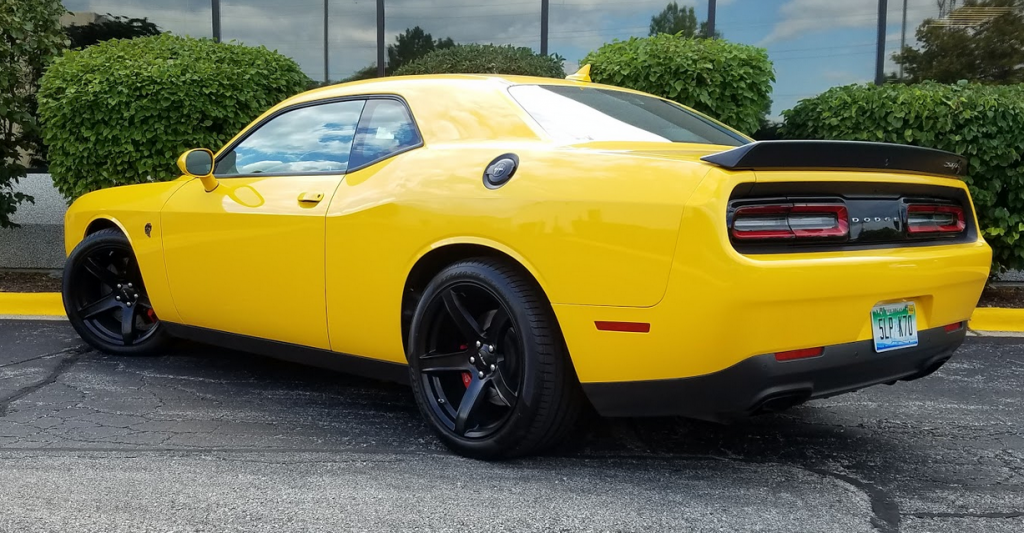
Then, too, parent Fiat Chrysler Automobiles has become so fixated on its Jeep and Ram truck lines that most Dodge- and Chrysler-brand vehicles that haven’t already been eliminated are being left to press on without much development. Under these circumstances, the Hellcat fundamentally remains what it has been since its arrival for 2015—and that purpose was to be an attention-grabbing extension of the modern Challenger that came out in 2008.
It’s still the same big coupe on a shortened Charger sedan platform powered by a 6.2-liter Hemi V8 topped with a twin-screw supercharger, an engine that generates peak horsepower at 6000 rpm and 650 lb-ft of torque at 4000 revs. A 6-speed manual transmission is standard, but the Hellcat tested by Consumer Guide® was fitted with a beefed-up TorqueFlite 8-speed automatic with manual-shift capability and steering-wheel-mounted shift paddles.
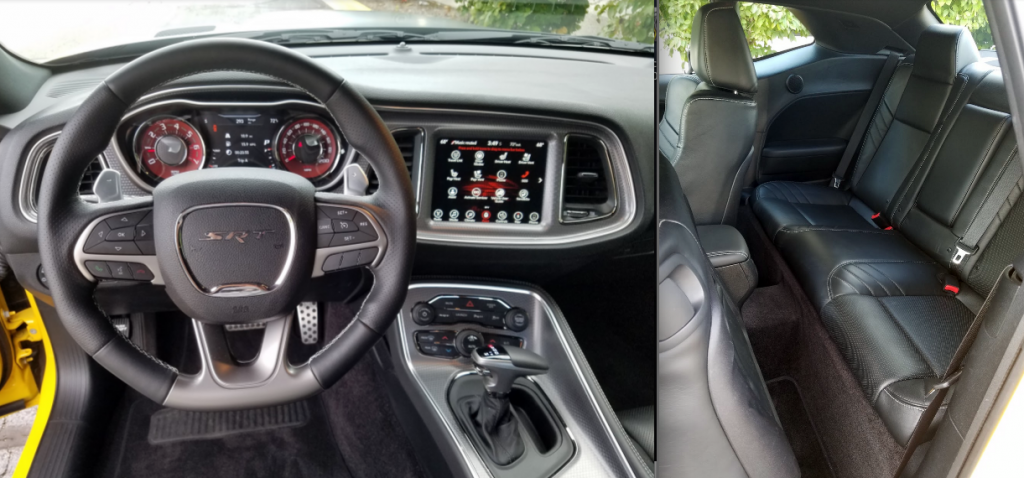
Naturally, all that power means never having to endure a slow off-the-line start or labored highway passing if the road ahead is open. Zero-to-60 mph is reported to come up in 4 seconds or less, with quarter-mile blasts below the 12-second mark—both of which we believe from on-track experience gleaned when the car was introduced. In the basic “Default” driving mode, the Hellcat is surprisingly livable. Tapping on the “Sport” or “Track” settings lets the automatic trans stay in gear a little longer before upshifting, and standard launch control can be deployed to help keep the rear tires from dying before their time. Paddle shifts are executed immediately. Electronically controlled valves in the large-diameter exhaust pipes let the Hellcat roar upon start-up and any time you put your right foot down out on the road.
Hellcat EPA fuel-economy ratings are decidedly modest—just 13 mpg in city driving, 22 mpg on the highway, and 16 combined with the automatic. Even then they can be hard to meet. For instance, this reviewer averaged a mere 12.27 miles per premium-fueled gallon after a 124.8-mile test drive that included 73 percent city-style operation. There is an “Eco” drive setting; anyone with the discipline to keep it on while piloting one of these snarling little monsters might have some better chance of matching the official projections.
Dodge Goes Wide: Meet the 2018 Challenger SRT Hellcat Widebody
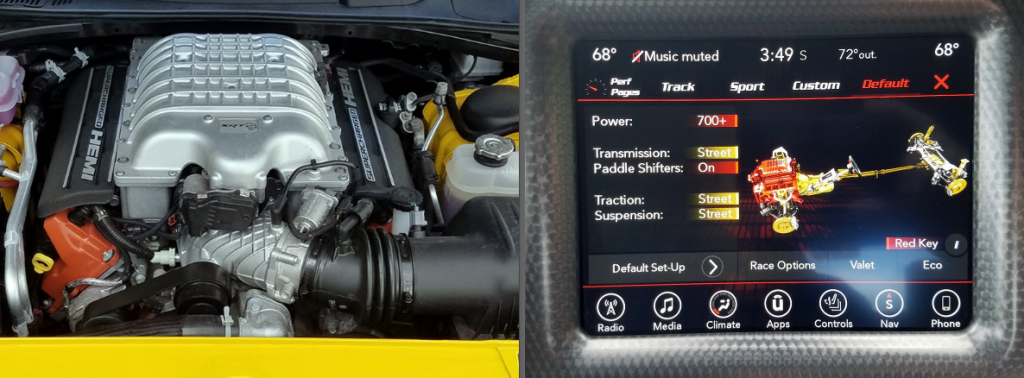
The Challenger’s size and weight reduce its handling prowess somewhat, but have a positive impact on ride comfort. Even the Hellcat, with its decidedly firmed-up suspension and 20-inch alloy wheels shod with low-profile Pirelli performance tires, is surprisingly comfortable in Default and Sport modes. The Sport and Track selections stiffen suspension damping and steering feel. Big Brembo disc brakes, with 6-piston calipers in front, deliver serious stopping power, all without inordinate pedal effort.
As noted, the Challenger’s size also affords it some advantages in interior room and trunk space. Front passengers will find pretty good space for legs and elbows, and—relative to other cars in the class—a couple of adults who wriggle into the rear seats will be able to sit upright and with tolerable room for feet and knees. The Dodge’s comparatively high, squared-off roof design allows for decent headroom all around, though wide sail panels blot out a lot of over-the-shoulder driver sightlines. The trunk is fairly large with a flat floor throughout, even though it narrows slightly between the wheelhouses. The rear seats fold in a 60/40 split for added carrying capacity—however they don’t rest especially flat, and the bulkhead behind them somewhat restricts the size of items that can be passed through.

Interior appointments aren’t overly luxurious but a few elements like well-bolstered front bucket seats (heated and ventilated, no less); leather upholstery; a leather-wrapped steering wheel; soft-touch surfaces on the armrests, door centers, and console-box lid; and dash and console trim with the look of engine-turned metal ward off starkness. Cabin storage includes a roomy bi-level glove box, a covered console box with a power point and media-device ports within, covered cup holders in the console, bottle holders in the doors, pouches on the backs of the front seats, and cup holders in the central armrest that pulls down from the middle of the back seat.
One new feature for 2017 Challengers is the addition of Apple CarPlay and Android Auto smartphone connectivity with the Uconnect infotainment system. The version of the system in the Hellcat has an 8.4-inch touchscreen that accesses audio; navigation; and “Performance Pages” that display speed and braking timers, g-force meters, and more. The ’Cat has a distinct grille/fascia design with an air splitter to direct the flow of cooling air and a large lower intake that can be removed for track sessions to increase airflow. An aluminum hood—painted black at extra cost—incorporates a functional scoop and extractor vents for cooling and to relieve underhood air turbulence. A “high-downforce” decklid spoiler is another Hellcat touch. Other key standards are an antislip axle, rear parking assist, blind-spot and rear cross-traffic detection, heated steering wheel, automatic dual-zone climate control, Bluetooth connectivity, 18-speaker audio with subwoofer, and satellite radio and travel/traffic services.
The Hellcat’s prodigious performance comes for a starting price of $62,495, but a few options, delivery, and a $1700 gas-guzzler tax pumped the Yellow Jacket-painted test car’s bottom line up to $70,975. While costly for a Challenger, that’s not really too much if no-holds-barred performance is your thing—and it’s tractable enough for regular use. There’s still nothing else quite like it.
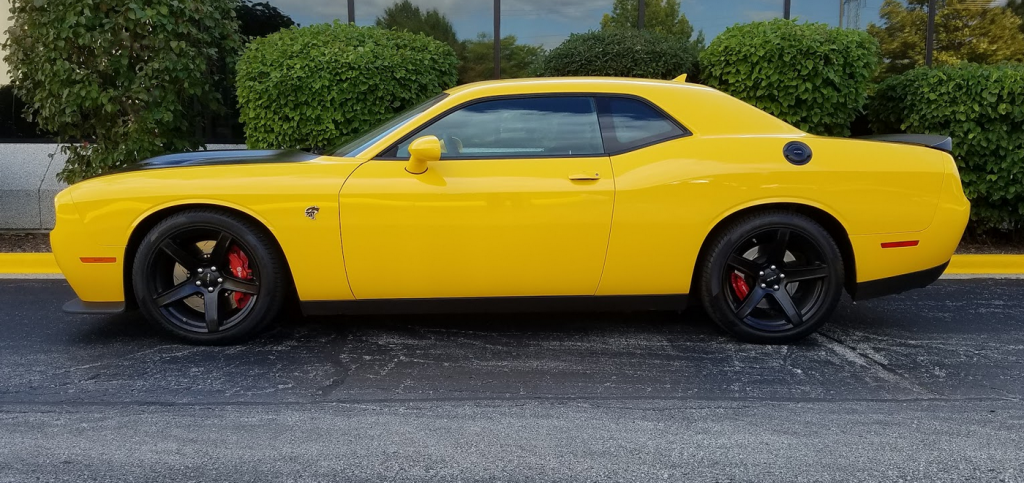
Test Drive: 2017 Chevrolet Corvette Grand Sport Convertible

